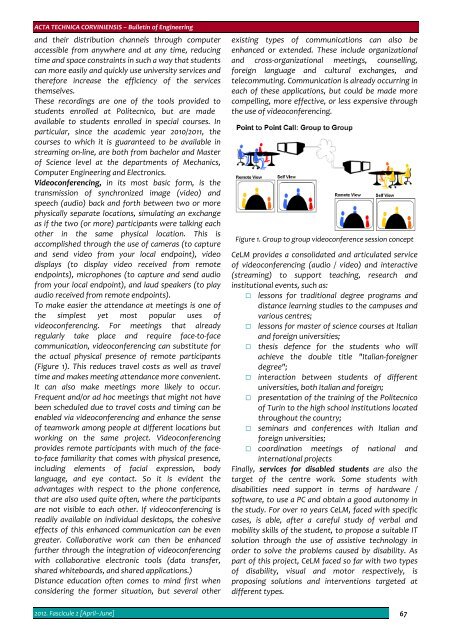Editorial & Advisory Board - Acta Technica Corviniensis
Editorial & Advisory Board - Acta Technica Corviniensis
Editorial & Advisory Board - Acta Technica Corviniensis
You also want an ePaper? Increase the reach of your titles
YUMPU automatically turns print PDFs into web optimized ePapers that Google loves.
ACTA TECHNICA CORVINIENSIS – Bulletin of Engineering<br />
and their distribution channels through computer<br />
accessible from anywhere and at any time, reducing<br />
time and space constraints in such a way that students<br />
can more easily and quickly use university services and<br />
therefore increase the efficiency of the services<br />
themselves.<br />
These recordings are one of the tools provided to<br />
students enrolled at Politecnico, but are made<br />
available to students enrolled in special courses. In<br />
particular, since the academic year 2010/2011, the<br />
courses to which it is guaranteed to be available in<br />
streaming on‐line, are both from bachelor and Master<br />
of Science level at the departments of Mechanics,<br />
Computer Engineering and Electronics.<br />
Videoconferencing, in its most basic form, is the<br />
transmission of synchronized image (video) and<br />
speech (audio) back and forth between two or more<br />
physically separate locations, simulating an exchange<br />
as if the two (or more) participants were talking each<br />
other in the same physical location. This is<br />
accomplished through the use of cameras (to capture<br />
and send video from your local endpoint), video<br />
displays (to display video received from remote<br />
endpoints), microphones (to capture and send audio<br />
from your local endpoint), and laud speakers (to play<br />
audio received from remote endpoints).<br />
To make easier the attendance at meetings is one of<br />
the simplest yet most popular uses of<br />
videoconferencing. For meetings that already<br />
regularly take place and require face‐to‐face<br />
communication, videoconferencing can substitute for<br />
the actual physical presence of remote participants<br />
(Figure 1). This reduces travel costs as well as travel<br />
time and makes meeting attendance more convenient.<br />
It can also make meetings more likely to occur.<br />
Frequent and/or ad hoc meetings that might not have<br />
been scheduled due to travel costs and timing can be<br />
enabled via videoconferencing and enhance the sense<br />
of teamwork among people at different locations but<br />
working on the same project. Videoconferencing<br />
provides remote participants with much of the faceto‐face<br />
familiarity that comes with physical presence,<br />
including elements of facial expression, body<br />
language, and eye contact. So it is evident the<br />
advantages with respect to the phone conference,<br />
that are also used quite often, where the participants<br />
are not visible to each other. If videoconferencing is<br />
readily available on individual desktops, the cohesive<br />
effects of this enhanced communication can be even<br />
greater. Collaborative work can then be enhanced<br />
further through the integration of videoconferencing<br />
with collaborative electronic tools (data transfer,<br />
shared whiteboards, and shared applications.)<br />
Distance education often comes to mind first when<br />
considering the former situation, but several other<br />
existing types of communications can also be<br />
enhanced or extended. These include organizational<br />
and cross‐organizational meetings, counselling,<br />
foreign language and cultural exchanges, and<br />
telecommuting. Communication is already occurring in<br />
each of these applications, but could be made more<br />
compelling, more effective, or less expensive through<br />
the use of videoconferencing.<br />
Figure 1. Group to group videoconference session concept<br />
CeLM provides a consolidated and articulated service<br />
of videoconferencing (audio / video) and interactive<br />
(streaming) to support teaching, research and<br />
institutional events, such as:<br />
lessons for traditional degree programs and<br />
distance learning studies to the campuses and<br />
various centres;<br />
lessons for master of science courses at Italian<br />
and foreign universities;<br />
thesis defence for the students who will<br />
achieve the double title "Italian‐foreigner<br />
degree";<br />
interaction between students of different<br />
universities, both Italian and foreign;<br />
presentation of the training of the Politecnico<br />
of Turin to the high school institutions located<br />
throughout the country;<br />
<br />
seminars and conferences with Italian and<br />
foreign universities;<br />
coordination meetings of national and<br />
international projects<br />
Finally, services for disabled students are also the<br />
target of the centre work. Some students with<br />
disabilities need support in terms of hardware /<br />
software, to use a PC and obtain a good autonomy in<br />
the study. For over 10 years CeLM, faced with specific<br />
cases, is able, after a careful study of verbal and<br />
mobility skills of the student, to propose a suitable IT<br />
solution through the use of assistive technology in<br />
order to solve the problems caused by disability. As<br />
part of this project, CeLM faced so far with two types<br />
of disability, visual and motor respectively, is<br />
proposing solutions and interventions targeted at<br />
different types.<br />
2012. Fascicule 2 [April–June] 67

















